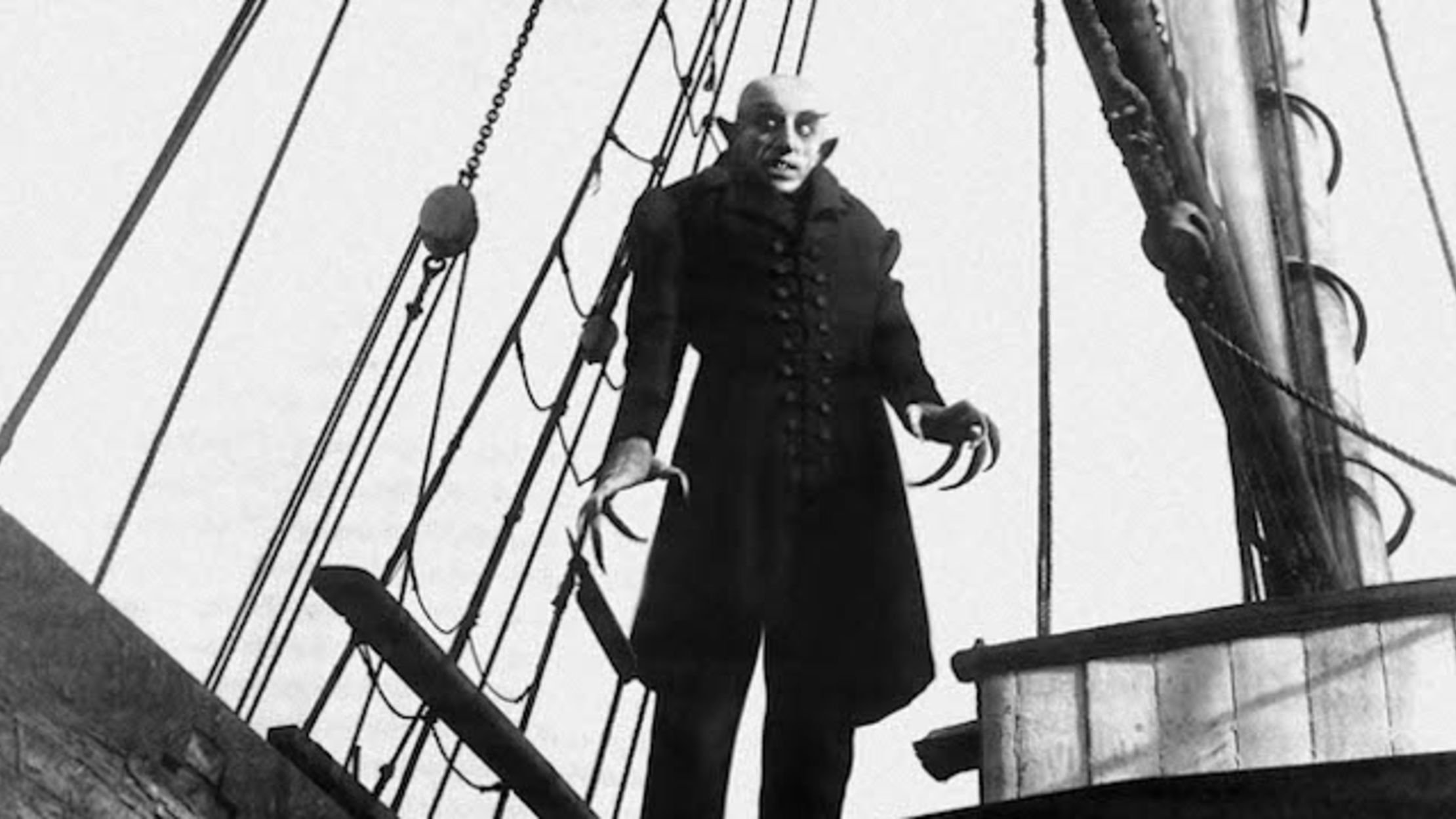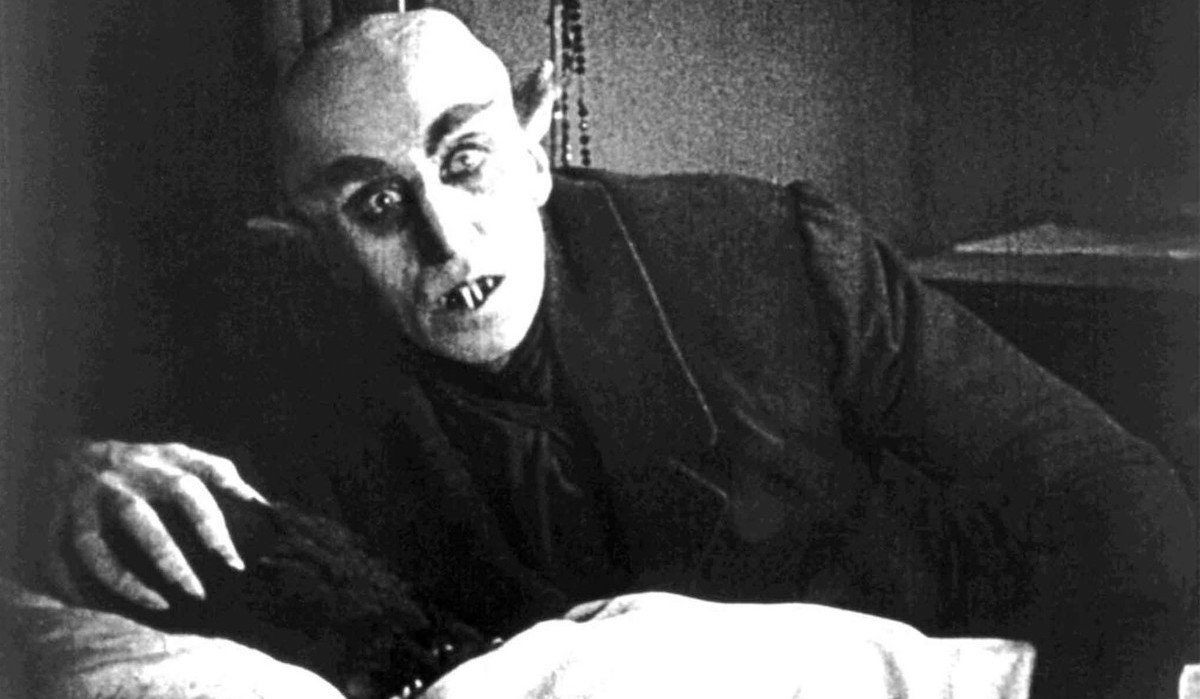Roundtable: The 100th Anniversary of Nosferatu: A Symphony of Horror (1922)
Aren: March 4, 2022 marks the 100th anniversary of the release of F. W. Murnau’s Nosferatu: A Symphony of Horror. An unauthorized adaptation of Bram Stoker’s Dracula, Murnau’s film remains the most lauded adaptation of the famous vampire novel, and I’d say the best as well. Any film hitting its 100th anniversary is still a rare and noteworthy occasion, given the relatively short history of film art, but this centenarian also remains a touchstone in cinema in the 21st century. So why does this landmark horror film remain so good even a century later?
Anton: I think one reason Nosferatu continues to have such an impact and influence on film is that it seems to hold a regular place in the emergent film buff’s journey through film history. Throw in two other facts—first, that Nosferatu contains one of the first (or perhaps the first) cinematic portraits of a horror icon, Dracula; and, second, that the movie has remained widely available for an early film, especially since the advent of home video—and you have the makings of an accessible gateway into silent cinema.
This is how the film functioned for me at least. I think Nosferatu is the first silent feature I ever watched. It’s either Nosferatu or Fritz Lang’s Metropolis. I believe I watched both of them at some point in high school, when I really began delving into film history. I bought this cheap DVD of the movie, which I think I found in some bargain bin in a grocery store. The soundtrack was by some metal band.
When did you guys first encounter the film? Am I right in saying it’s probably a go-to first silent feature for many film buffs?
Aren: If my movie journals are to be trusted, the first silent film I watched was Buster Keaton’s The General. However, Nosferatu was the second, followed closely by Metropolis a few weeks later. I watched them all in high school and was pretty taken with them, even if I didn’t really deep-dive into silent film until I was older.
Anders: I cannot be sure when I first watched it, but I believe I was in my late teens and it would definitely be among the first silent films I watched, though I believe I saw Metropolis and some Chaplin first. It’s definitely among the go-to entry points to silent cinema because of its genre affiliation, which also goes for Metropolis. It also helps that both Murnau and Lang had later careers in America after leaving Germany. I have since taught Nosferatu to students as the first film in my Gothic and horror film class since it so nicely brings together those traditions through its adaptation of one of the key Gothic novels by way of German Expressionism.
Anton: Yes, Nosferatu’s place in a tradition—both as a work drawing on antecedents in Gothic and horror, and as one of the founding texts of the horror genre in film—makes it the kind of the movie that demands genre fans seek it out. It’s a key that picks the lock of a lot of later films.
The same goes for the other silent movies I encountered early on, such as Metropolis, which I had always wanted to see because of Star Wars, after I discovered the impact Metropolis had on Lucas and his portrayal of C-3PO.
And like the work of Chaplin and Buster Keaton, Nosferatu is one of those silent movies that still inhabits the public consciousness, emblematized in the clips that make their way into most any montage of film or genre history.
Aren: Look at the silent films that we mention as our gateway films to the Silent Era—they all fall into two types: German Expressionist films and American vaudeville comedies. I’d argue these remain the most popular types of silent films to this day. If someone has only seen one or two silent films, odds are it’s Nosferatu or Metropolis or The Cabinet of Dr. Caligari or one of the major Charlie Chaplin or Buster Keaton films.
But there is something special about Nosferatu, even compared to these other films: it remains scary.
Nosferatu as a Horror Film
Anton: I agree. It remains effective in a way that most silent films just aren’t. Many of the forms of emotion conveyed by silent acting are difficult to appreciate today, and they remain distancing for me. Nosferatu, in contrast, contains the essence of what still works in a horror film: generating suspense and dread, especially through cross-cutting; the creation and use of disturbing costumes and make-up effects; and the use of editing to startle the audience. I’m thinking of when Hutter, the young clerk (Gustav von Wangenheim), takes the lid off the coffin, and sees the vampire’s open-eyed sleeping face.
Watching Nosferatu late, late at night by myself as a teenager, I remember being creeped out. I watched it again late last night, and it’s still unsettling. There’s something about the film’s atmosphere—there’s the hypnotic effect of its silence and patience; that it was shot on actual locations; that the excellent make-up for Count Orlok, combined with Max Schrek’s great performance, is so creepy—that Nosferatu almost feels like an old discovered film from the 19th century, when most Dracula tales are set. I’m thinking especially of the scene near the end when we watch Nosferatu slowly suck Ellen’s (Greta Schröder) neck, and then he looks up at the camera.
Aren: What you’re mentioning is almost a found-footage quality to the film, which I think is not simply a retroactive extrapolation on our part, but a deliberate element that Murnau thought about when making the movie (even if he would’ve never termed it as such).
Back in 2016, when Toronto Film Scene was still a thing, I wrote a piece on Murnau’s key silent films. (I’ve posted it on our site as the original post was erased when the website was taken down.) In the piece, I point out that Murnau differentiates from other German Expressionist films by shooting Nosferatu on real locations in Eastern Europe, real castle ruins, real hillsides. Movies such as The Cabinet of Dr. Caligari and Paul Wegener’s The Golem: How He Came Into the World were extremely stylized films shot in studios with painted shadows, crooked building sets, and a controlled atmosphere. They’re brilliant to look at, but there’s nothing that passes for real life in their presentation.
But Nosferatu lets the real undergird the fantasy, which I think goes to explain why the film has such a hold over our imaginations even today. It seems credible, and as you say, Anton, the more distance we get from it, the more it seems to be an almost visual archive of the Dracula story itself, not simply a film adaptation from a few decades after its publication.
Anton: I just want to jump in here and note that Bram Stoker’s Dracula was published in 1897. Murnau’s film was made only 25 years after the novel came out. 100 years now stand between us and Murnau’s film. There’s much less time between the novel’s publication and Murnau’s film than there is between us and his film. It was like someone adapting a horror novel from the 1990s. Dracula was a relatively recent work, so Murnau does not approach Dracula as a classic—he has no problem changing names and locations, for instance. That further points to the immediacy and dynamic, rather than static, approach of the film to the literary text.
Aren: The approach is such that you can almost say it’s real footage, which is a concept that gave birth to E. Elias Merhige’s Shadow of the Vampire, starring Willem Dafoe as Max Schreck, who played Count Orlok in the film. The movie posits that Schreck was a real vampire and Murnau (played by John Malkovich) used real evil to conjure the portrait of evil in the film.
Anders: I was going to mention the film’s legacy, through Shadow of the Vampire and also the 1979 remake by Werner Herzog, starring Klaus Kinski as the vampire. Nosferatu remains a key work in vampire film and fiction, as Murnau’s Count Orlok provides a visual archetype that is used in films such as Guillermo del Toro’s Blade II. And so, it feels less like some strange relic of, now, 100 years ago, and rather a key contribution to vampire lore.
But to briefly return to the point that Nosferatu almost achieves a feel of documentary, this is completely in line with the history of both Gothic fiction and later horror (such as Aren’s favourite, found-footage horror). So, it’s not an innovation, but rather being true to the history of Gothic texts that pass themselves off as “authentic,” from the foundational Gothic novel, The Castle of Otranto (1764), to the film’s source material in Bram Stoker’s epistolary novel.
Anton: After all, in Nosferatu, intertitle cards made to look like the pages of a book set up the film as “An Account of the Great Death in Wisborg, anno domini 1838.”
Anders: Murnau was definitely a key in bringing the Gothic horror tradition to the screen, since he had earlier made The Haunted Castle (1921) as well as a now lost unauthorized version of Dr. Jekyll and Mr. Hyde entitled The Head of Janus in 1920, again changing some of the names and details.
Anton: Oh no, that’s such a shame it’s lost. I would love to see Murnau doing Jekyll and Hyde.
Nosferatu as a Murnau Film
Anton: But we should also talk about the film as the conscious artistic construction of F. W. Murnau, one of the greats of silent cinema. Where does Murnau land among your favourite silent filmmakers? Is Nosferatu your favourite of his films?
Aren: After Chaplin and Keaton, Murnau might be my favourite silent filmmaker. Fritz Lang transitioned into film noir and is arguably more iconic for his sound films, so I don’t want to group him in the same category as a filmmaker like Murnau, who worked strictly in the Silent Era. (He died tragically a week before the release of Tabu, his final film, in 1931.)
I love Nosferatu, but I love Sunrise: A Song of Two Humans even more. It’s just so astounding from a technical side that I like it more each viewing. I think it’s one of the best movies ever made. I also hugely admire The Last Laugh, which is notable for its single use of an intertitle card, and Faust, although both of those films are more sentimental than Nosferatu or Sunrise.
Anton: I’ve always preferred Nosferatu. Faust is more stylized, with the creepy figures flying through the air. I’ve only seen Sunrise once, and I think it’s due another viewing. After all, Sunrise always ranks so high on the Sight and Sound poll.
Anders: Like you, Aren, I admire Sunrise slightly more, but that list of four films you mention surely cements Murnau among the silent cinema greats. Nosferatu also points to the way that before sound, cinema could be, in theory, more international and less cemented to particular linguistic realms, since apart from Chaplin and Keaton, you made the point earlier that German Expressionism and other German films from the late-Weimar Era are among the most popular and well-remembered silent films.
Nosferatu: A Symphony of Horror (1922, Germany)
Directed by F. W. Murnau; screenplay by Henrick Galeen, based on the novel by Bram Stoker; starring Max Schrek, Gustav von Wangenheim, Greta Schröder, Alexander Granach, Ruth Landshoff, and Wolfgang Heinz.





Anders and Anton discuss their appreciation of the third season of The Bear and the mixed critical reception to the latest season of the hit show.